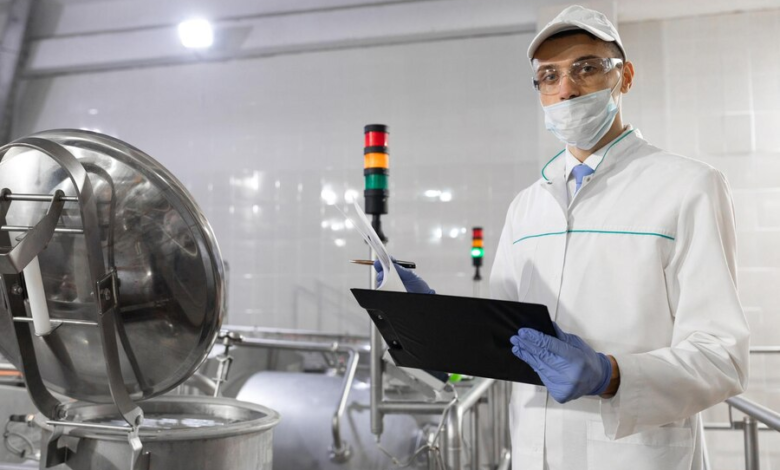How Technology is Shaping Food Safety Standards Today

As global food supply chains grow more complex, food safety standards have become increasingly stringent. Ensuring food safety has become a top priority for companies at every level of production, from farming and manufacturing to distribution and retail. Technology is playing a transformative role in helping companies meet these high standards, not only improving efficiency but also enhancing compliance with food safety regulations.
With technological innovations like digital food safety management systems, predictive analytics, and HACCP software, the food industry is now equipped with advanced tools to ensure that every step of the process aligns with rigorous safety protocols.
In this article, we’ll explore the latest technological trends that are shaping food safety standards, the benefits of adopting these advancements, and how they impact compliance, efficiency, and overall quality in the food industry.
The Importance of Technology in Food Safety
The role of technology in food safety is increasingly important as the industry faces several challenges. From managing complex supply chains to ensuring compliance with local and international regulations, technology provides solutions that improve accuracy, traceability, and operational efficiency. Food companies that adopt these technologies not only mitigate risks but also position themselves as trustworthy brands focused on delivering safe and quality products.
- Increasing Compliance Requirements: Regulatory authorities worldwide continue to raise standards for food safety. With stricter regulations and more detailed documentation requirements, companies are turning to technology to streamline compliance efforts.
- Enhanced Consumer Expectations: Consumers today expect more transparency and accountability from the food industry. Technology helps food businesses address these expectations by providing traceable data and visible quality checks throughout the supply chain.
- Reducing Risks and Liabilities: By implementing automated monitoring and real-time data collection, companies can identify potential hazards before they escalate, reducing risks associated with foodborne illnesses and product recalls.
Digital Food Safety Management Systems
A food safety management system (FSMS) is crucial for maintaining consistent food safety standards. Digital FSMS platforms offer a streamlined approach to monitoring, documenting, and analyzing food safety processes across an organization. These systems centralize data and offer comprehensive dashboards, making it easier for food safety managers to access critical information and address issues immediately.
Benefits of Digital FSMS
- Real-Time Monitoring: Digital FSMS can continuously monitor food production environments, providing real-time alerts for potential hazards.
- Automated Documentation: With automated data recording, companies can save time on manual documentation, reduce errors, and improve the accuracy of records.
- Improved Compliance: FSMS software helps businesses maintain compliance by keeping up-to-date with the latest regulatory requirements, reducing the risk of costly violations.
- Seamless Audits: Having a digital record of food safety processes enables businesses to conduct efficient audits. FSMS systems make it easy to retrieve data and demonstrate compliance to auditors.
HACCP Software for Proactive Hazard Control
Hazard Analysis and Critical Control Points (HACCP) is a well-known approach to food safety that focuses on identifying and controlling potential hazards. HACCP software takes this methodology to the next level by integrating it into a digital platform, allowing food safety managers to proactively monitor critical control points and ensure continuous compliance.
How HACCP Software Enhances Food Safety
- Automated Hazard Monitoring: HACCP software automates the tracking of critical control points, ensuring that each stage of production adheres to safety standards.
- Efficient Record-Keeping: By digitizing records, HACCP software simplifies the documentation process, making it easier to maintain and retrieve data for audits and reviews.
- Risk-Based Analysis: HACCP software provides analytical tools that help food safety managers identify patterns in hazard data, enabling preventive actions before issues arise.
- Compliance Support: HACCP software is designed to align with regulatory requirements, reducing the chances of violations and helping businesses maintain a proactive approach to safety.
Data Analytics and Predictive Modeling
One of the most exciting developments in food safety technology is the use of data analytics and predictive modeling. These tools allow companies to analyze large volumes of data and make predictions about potential risks. By understanding patterns in data, businesses can predict potential contamination or quality issues and take preventive measures.
Key Advantages of Predictive Analytics in Food Safety
- Early Risk Detection: Predictive analytics can identify risk factors that may lead to contamination, allowing for preventive actions that avoid foodborne illnesses.
- Data-Driven Decision Making: With data analytics, food safety managers can make informed decisions based on insights from historical data, enhancing the efficiency of food safety protocols.
- Continuous Improvement: Analytics provide insights into areas that need improvement, helping organizations fine-tune their processes and adapt to changing safety standards.
Blockchain and Traceability in Food Supply Chains
Blockchain technology has emerged as a valuable tool for food traceability. It provides a transparent and immutable record of every step in the food supply chain, from raw materials to the end consumer. With blockchain, every participant in the supply chain has access to the same information, enhancing transparency and accountability.
How Blockchain Benefits Food Safety
- Enhanced Traceability: Blockchain provides a verifiable trail of food products, making it easy to track the origin and journey of any item in the supply chain.
- Quick Recall Process: If a contamination is detected, blockchain enables companies to quickly identify affected products and remove them from the supply chain, reducing risks to consumers.
- Increased Consumer Trust: Blockchain’s transparency helps build consumer trust by demonstrating a commitment to high food safety standards and honest practices.
- Reduced Fraud and Counterfeiting: Blockchain helps prevent fraud by verifying the authenticity of food products, ensuring that only genuine items reach consumers.
The Future of Food Safety Technology
The food industry will likely see continued advancements in technology that enhance food safety. Emerging trends include the use of artificial intelligence for more accurate risk predictions, IoT devices for enhanced monitoring, and machine learning for improved quality control. Companies that stay on top of these trends will not only improve their food safety standards but also gain a competitive edge in an increasingly demanding market.
- AI for Quality Assurance: AI algorithms can detect irregularities in food production faster and more accurately than human inspectors, reducing contamination risks.
- IoT for Environment Monitoring: IoT devices monitor temperature, humidity, and other environmental factors in real-time, providing instant alerts for any irregularities.
- Machine Learning for Continuous Improvement: Machine learning algorithms can help organizations improve their processes over time, reducing errors and ensuring consistent compliance with food safety regulations.
Conclusion
Technology is fundamentally reshaping the way food safety standards are implemented and maintained. Digital food safety management systems and HACCP software are making it easier for companies to comply with regulations, monitor food quality, and protect consumer health. By adopting tools like blockchain for traceability and predictive analytics for risk assessment, businesses can proactively safeguard their operations and meet the demands of an increasingly health-conscious public.
As these technologies continue to evolve, companies that invest in food safety innovations today will be better equipped to face the challenges of tomorrow, ensuring that their products remain safe, trustworthy, and compliant with the highest industry standards.




